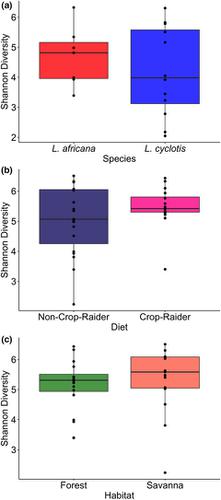当前位置:
X-MOL 学术
›
Ecol. Evol.
›
论文详情
Our official English website, www.x-mol.net, welcomes your feedback! (Note: you will need to create a separate account there.)
Effects of diet, habitat, and phylogeny on the fecal microbiome of wild African savanna (Loxodonta africana) and forest elephants (L. cyclotis).
Ecology and Evolution ( IF 2.6 ) Pub Date : 2020-05-18 , DOI: 10.1002/ece3.6305 Kris Budd 1 , Joe C Gunn 1 , Tabitha Finch 1, 2 , Katy Klymus 1, 3 , Noah Sitati 4 , Lori S Eggert 1
Ecology and Evolution ( IF 2.6 ) Pub Date : 2020-05-18 , DOI: 10.1002/ece3.6305 Kris Budd 1 , Joe C Gunn 1 , Tabitha Finch 1, 2 , Katy Klymus 1, 3 , Noah Sitati 4 , Lori S Eggert 1
Affiliation

|
The gut microbiome, or the community of microorganisms inhabiting the digestive tract, is often unique to its symbiont and, in many animal taxa, is highly influenced by host phylogeny and diet. In this study, we characterized the gut microbiome of the African savanna elephant (Loxodonta africana ) and the African forest elephant (Loxodonta cyclotis ), sister taxa separated by 2.6–5.6 million years of independent evolution. We examined the effect of host phylogeny on microbiome composition. Additionally, we examined the influence of habitat types (forest versus savanna) and diet types (crop‐raiding versus noncrop‐raiding) on the microbiome within L. africana . We found 58 bacterial orders, representing 16 phyla, across all African elephant samples. The most common phyla were Firmicutes, Proteobacteria, and Bacteroidetes. The microbiome of L. africana was dominated by Firmicutes, similar to other hindgut fermenters, while the microbiome of L. cyclotis was dominated by Proteobacteria, similar to more frugivorous species. Alpha diversity did not differ across species, habitat type, or diet, but beta diversity indicated that microbial communities differed significantly among species, diet types, and habitat types. Based on predicted KEGG metabolic pathways, we also found significant differences between species, but not habitat or diet, in amino acid metabolism, energy metabolism, and metabolism of terpenoids and polyketides. Understanding the digestive capabilities of these elephant species could aid in their captive management and ultimately their conservation.
中文翻译:

饮食,生境和系统发育对野生非洲大草原(Loxodonta africana)和森林象(L.cyclotis)粪便微生物组的影响。
肠道微生物组或居住在消化道中的微生物群落通常是其共生体所特有的,在许多动物类群中,肠道菌群受到宿主系统发育和饮食的高度影响。在这项研究中,我们对非洲大草原象(Loxodonta africana)和非洲森林象(Loxodonta cyclotis)的肠道微生物组进行了表征,它们的姐妹类群被分开了2.6-560万年的独立进化。我们检查了宿主系统发育对微生物组组成的影响。此外,我们研究了栖息地类型(森林与热带稀树草原)和饮食类型(农作物与非农作物)对非洲象牙菌内微生物组的影响。。我们在所有非洲象样本中发现了58个细菌阶,代表16个门。最常见的门系是Firmicutes,Proteobacteria和Bacteroidetes。的微生物L. AFRICANA被厚壁菌门,类似于其他的后肠发酵为主,而的微生物L. cyclotis由变形杆菌控制,类似于节食性物种。α多样性在物种,生境类型或饮食之间没有差异,但是β多样性表明微生物群落在物种,饮食类型和生境类型之间存在显着差异。基于预测的KEGG代谢途径,我们还发现氨基酸代谢,能量代谢以及萜类和聚酮化合物的代谢在物种之间(而非栖息地或饮食)之间存在显着差异。了解这些大象的消化能力可以帮助他们进行圈养,并最终保护它们。
更新日期:2020-06-26
中文翻译:

饮食,生境和系统发育对野生非洲大草原(Loxodonta africana)和森林象(L.cyclotis)粪便微生物组的影响。
肠道微生物组或居住在消化道中的微生物群落通常是其共生体所特有的,在许多动物类群中,肠道菌群受到宿主系统发育和饮食的高度影响。在这项研究中,我们对非洲大草原象(Loxodonta africana)和非洲森林象(Loxodonta cyclotis)的肠道微生物组进行了表征,它们的姐妹类群被分开了2.6-560万年的独立进化。我们检查了宿主系统发育对微生物组组成的影响。此外,我们研究了栖息地类型(森林与热带稀树草原)和饮食类型(农作物与非农作物)对非洲象牙菌内微生物组的影响。。我们在所有非洲象样本中发现了58个细菌阶,代表16个门。最常见的门系是Firmicutes,Proteobacteria和Bacteroidetes。的微生物L. AFRICANA被厚壁菌门,类似于其他的后肠发酵为主,而的微生物L. cyclotis由变形杆菌控制,类似于节食性物种。α多样性在物种,生境类型或饮食之间没有差异,但是β多样性表明微生物群落在物种,饮食类型和生境类型之间存在显着差异。基于预测的KEGG代谢途径,我们还发现氨基酸代谢,能量代谢以及萜类和聚酮化合物的代谢在物种之间(而非栖息地或饮食)之间存在显着差异。了解这些大象的消化能力可以帮助他们进行圈养,并最终保护它们。


























 京公网安备 11010802027423号
京公网安备 11010802027423号